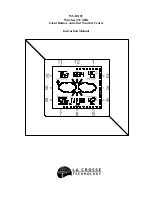
June 23, 2023
page
2
(1)
For devices powered by batteries integrated into the housing, triple-click button 2, then double-click button 2 to reset the device without removing the battery.
R70SR SNAP SIGNAL™ Serial Data Radio
•
•
•
Configure the DIP Switches
Before changing DIP switch positions, disconnect the power
(1)
. Any changes made to the DIP switches are not recognized until after power is
cycled to the device. For parameters not set using the DIP switches, use the configuration software to make configuration changes. For para
meters set using the DIP switches, the DIP switch positions override any changes made using the configuration software.
Open the Cover
If the cover is in the locked position, the arrow on the cover is above the notch on the base. Follow these steps to unlock and remove the
cover.
Serial Mode vs MultiHop Mode for R70SR Data Radios
As of early 2023, the R70SR Serial Data Radio firmware allows the radio to be configured as either a serial data radio or a MultiHop data ra
dio that is compatible with other Banner Sure Cross MultiHop data radios. These updated R70SR serial data radios also contain an addition
al ID label on the device to assist with MultiHop site surveys. Ignore this label when your radio is operating in serial data radio mode. R70SR
serial data radios manufactured before date code xxxx have different DIP switch configurations. Please refer to datasheet
for the
legacy R70SR model instructions.
Serial Mode--Serial Mode provides the simplest setup and best performance for point-to-point networks and small star networks. Serial mode
is not ideal for medium to large Star or Tree topologies because the client radio broadcasts all messages and does not build a routing table.
This results in slower communication, which is ideal for simple cable replacement applications. There is no need to adjust the Modbus ad
dress of connected devices, resulting in a simpler setup process.
MultiHop Data Radio Mode
MultiHop Data Radio mode requires more configuration but allows for much larger Star and Tree topologies be
cause the client radio builds a routing table to more efficiently communicate with each server device on the network. Configuring your data
radio as a MultiHop radio adds the ability to perform a site survey analysis with the MultiHop Configuration Software, offers improved perfor
mance in larger Star and Tree network topologies, and adds the ability to communicate with other Sure Cross MultiHop data radios including
the MutliHop DXM Wireless Controllers.
For additional information, refer to one of the following documents:
MultiHop Data Radio Quick Start Guide (p/n 152653)
MultiHop Data Radio Instruction Manual (p/n 151317)
MultiHop Register Guide (p/n 155289)
DIP Switch Settings for the R70SR in Serial Mode
Device Settings
Dip Switches
1
2
3
4
Serial Mode
Off
Serial Routed Mode
Off
Serial Broadcast Mode
ON
Server Mode
OFF
OFF
Set this radio to be a client radio. For 900 MHz models, set to 1 W (30dBm) transmit
power; for 2.4 GHz models the transmit power remains at 65 mW
OFF
ON
Set this radio to be a repeater radio (900 MHz or 2.4 GHz Models)
ON
OFF
Set this radio to be a server radio. For 900 MHz models, set to 250 mW (24dBm)
transmit power; for 2.4 GHz models the transmit power remains at 65 mW
ON
ON
Baud Rate and Parity
— The baud rate and parity are set to default at 19200; no parity. These settings are not configurable via the DIP
switches and must be changed using AT commands. These settings must match the device wired to the radio's serial port. A faster baud rate
setting may improve system response time. Changing the baud rate does NOT change the radio transmission rate. The software default also
provides the ability to set custom baud rate and timing parameter settings via AT commands. For more information, see the technical
note
Changing the Baud Rate and Parity on an R70SR Serial Data Radio
(p/n b_51173725).
Serial Routed Mode
—Use routed messaging when using a pointtopoint or pointtopointwithrepeater topology. Routing is more robust and
faster than broadcast messaging. In routed mode, the radios will route serial data packets only to a single device. In general, this mode is for
faster communications. If the server radios are in routed mode, they will only route serial data packets to the client radio and will only listen
for serial data packets coming from the client. If the client radio is in routed mode, it will only route serial data packets to the first server radio
that comes into the network. The client radio should only be in routed mode if used in a pointtopoint network.
Rotate the cover counterclockwise so that the notches are aligned together.
1.
Pull the top cover off.
2.
© Banner Engineering Corp.
































